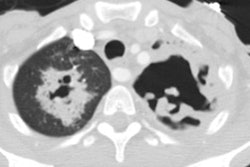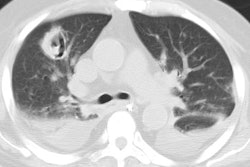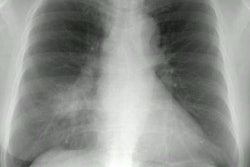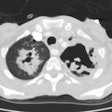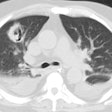Radiographics 2001 Jul-Aug;21(4):839-58
Thoracic sequelae and complications of tuberculosis.
Kim HY, Song KS, Goo JM, Lee JS, Lee KS, Lim TH.
Pulmonary tuberculosis is caused by Mycobacterium tuberculosis when droplet
nuclei laden with bacilli are inhaled. In accordance with the virulence of the
organism and the defenses of the host, tuberculosis can occur in the lungs and
in extrapulmonary organs. A variety of sequelae and complications can occur in
the pulmonary and extrapulmonary portions of the thorax in treated or untreated
patients. These can be categorized as follows: (a) parenchymal lesions, which
include tuberculoma, thin-walled cavity, cicatrization, end-stage lung
destruction, aspergilloma, and bronchogenic carcinoma; (b) airway lesions, which
include bronchiectasis, tracheobronchial stenosis, and broncholithiasis; (c)
vascular lesions, which include pulmonary or bronchial arteritis and thrombosis,
bronchial artery dilatation, and Rasmussen aneurysm; (d) mediastinal lesions,
which include lymph node calcification and extranodal extension,
esophagomediastinal or esophagobronchial fistula, constrictive pericarditis, and
fibrosing mediastinitis; (e) pleural lesions, which include chronic empyema,
fibrothorax, bronchopleural fistula, and pneumothorax; and (f) chest wall
lesions, which include rib tuberculosis, tuberculous spondylitis, and malignancy
associated with chronic empyema. These varieties of radiologic manifestations
can mimic other disease entities. Therefore, recognition and understanding of
the radiologic manifestations of the thoracic sequelae and complications of
tuberculosis are important to facilitate diagnosis.
